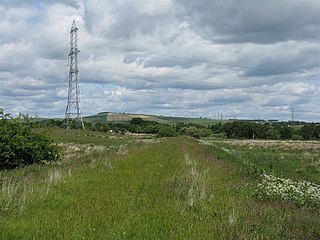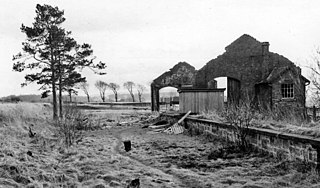See also
- Bank End, a village in Cumbria, England
Bankend may refer to:
Scottish usually refers to something of, from, or related to Scotland, including:
Scottish English is the set of varieties of the English language spoken in Scotland. The transregional, standardised variety is called Scottish Standard English or Standard Scottish English (SSE). Scottish Standard English may be defined as "the characteristic speech of the professional class [in Scotland] and the accepted norm in schools". IETF language tag for "Scottish Standard English" is en-scotland.
Alexander Mackenzie most commonly refers to:
Scots may refer to:

Coalburn is a village in South Lanarkshire, Scotland, UK. It is located near the villages of Auchlochan, Bankend and Braehead.
Margaret of Scotland may refer to:
Highway 743 is a highway in the Canadian province of Saskatchewan. It runs from Highway 640 near Krasne to Highway 310. Highway 743 is about 50 km (31 mi.) long.

Dumfries and Galloway Royal Infirmary is the main hospital in Dumfries, Scotland. The hospital is managed by NHS Dumfries and Galloway.
Bankend is a locality in the central part of Saskatchewan, Canada. Other communities in the area include Foam Lake, Ituna, Leslie, Wishart, West Bend and Leross. Bankend is located between the Touchwood Hills and the Beaver Hills. Bankend was a booming agricultural community in 1928, HWY 35 arrived, and four grain elevators were built.

The Barony of Bonshaw, previously known as Bollingshaw, was in the old feudal Baillerie of Cunninghame, near Stewarton in what is now North Ayrshire, Scotland.

The Rural Municipality of Emerald No. 277 is a rural municipality (RM) in the Canadian province of Saskatchewan within Census Division No. 10 and SARM Division No. 4.

The Lesmahgow Railway, south of Glasgow in Scotland, was developed by a company known as The Lesmahagow Branches. It was not an independent company in the usual sense. It was a financially independent, self-contained unit within the framework of the Caledonian Railway. The shareholders and officers of both companies were mainly the same people. The line was built largely to transport the vast amount coal being produced by the many mines in the area. Royal assent was given to build the line in 1847 but construction did not commence till 1854. In 1856 the line was opened in stages. Later there was found to be a demand for passenger services which commenced in 1868. In 1923, with the grouping, the CR amalgamated with several other companies to form the London, Midland and Scottish Railway (LMS) which, following nationalisation in 1947, became part of British Railways.
This article traces the Caledonian Railway branches in South Lanarkshire.

Brocketsbrae railway station served the hamlet of Brocketsbrae, South Lanarkshire, Scotland, from 1866 to 1951 on the Lesmahagow Junction to Bankend Colliery line.
The Coalburn Branch was a branch line constructed by the Caledonian Railway from Lesmahagow railway station to Bankend railway station. It was the main branch of the Lesmahagow Railway.
Bankend railway station served Bankend, a village in South Lanarkshire, Scotland. It closed in 1926 and the area became an opencast coal mine.
Bankend is a village in South Lanarkshire, Scotland. It is located near the villages of Braehead, Coalburn and Cumberhead.

Lochar Water is a stream located in Dumfries and Galloway. It flows for about 10 miles or 16 km, mainly in a southerly direction, roughly parallel to the River Nith to the west and the River Annan to the east. It is formed by the confluence of Park Burn and Amisfield Burn, and skirts the eastern side of the town of Dumfries, and flows through an extensive low-lying area and former raised peat land known as Lochar Moss, before flowing into the Solway Firth. Bankend Bridge, part of the B725 road, crosses Lochar Water on the east side of Bankend village. The tidal limit is about 1 km below that. It shares its name with an electoral ward of the Dumfries and Galloway council